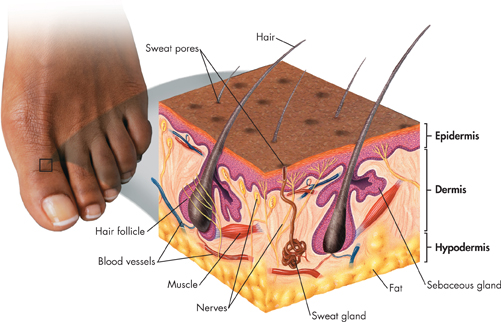
FIGURE 32–12 Structure of the Skin The skin has an outer layer called the epidermis and an inner layer called the dermis. Infer Why do you think a slight scratch on the surface of the skin does not bleed?
dIntegumentary System Structures
 What are the structures of the integumentary system?
What are the structures of the integumentary system?
Many structures are required to fulfill all the functions you just read about.  Skin and its related structures—the hair, nails, and several types of glands—make up the integumentary system. The skin is made up of two main layers—the epidermis and the dermis. Beneath the dermis is a layer of fat (the hypodermis) and loose connective tissue that helps insulate the body. Figure 32–12 shows many of the structures that make up the skin.
Skin and its related structures—the hair, nails, and several types of glands—make up the integumentary system. The skin is made up of two main layers—the epidermis and the dermis. Beneath the dermis is a layer of fat (the hypodermis) and loose connective tissue that helps insulate the body. Figure 32–12 shows many of the structures that make up the skin.
Epidermis The outer layer of the skin is the epidermis. The epidermis has two layers. The outer layer of the epidermis—the layer that you can see—is made up of dead cells. The inner layer of the epidermis is made up of living cells, including stem cells. These cells divide rapidly, producing new skin cells that push older cells to the surface of the skin. As the older cells move upward, they flatten, and their organelles disintegrate. They also begin making keratin, a tough, fibrous protein.
BUILD Vocabulary
WORD ORIGINS The prefix epi- in epidermis comes from the Greek word meaning “on” or “upon.” Dermis derives from the Greek derma, meaning “skin.”
Eventually, the older cells die and form a tough, flexible, waterproof covering on the surface of the skin. This outer layer of dead cells is shed or washed away at a surprising rate. Once every four to six weeks, a new layer of dead cells replaces an old layer.
The epidermis also contains melanocytes (MEL uh noh cytes), which are cells that produce a dark brown pigment called melanin. Melanin helps protect the skin by absorbing ultraviolet rays from the sun. Skin color is directly related to the production of melanin. The melanocytes of people with darker skin produce more melanin than the melanocytes of people with lighter skin produce.

Table of Contents
- Formulas and Equations
- Applying Formulas and Equations
- Mean, Median, and Mode
- Estimation
- Using Measurements in Calculations
- Effects of Measurement Errors
- Accuracy
- Precision
- Comparing Accuracy and Precision
- Significant Figures
- Calculating With Significant Figures
- Scientific Notation
- Calculating With Scientific Notation
- Dimensional Analysis
- Applying Dimensional Analysis




